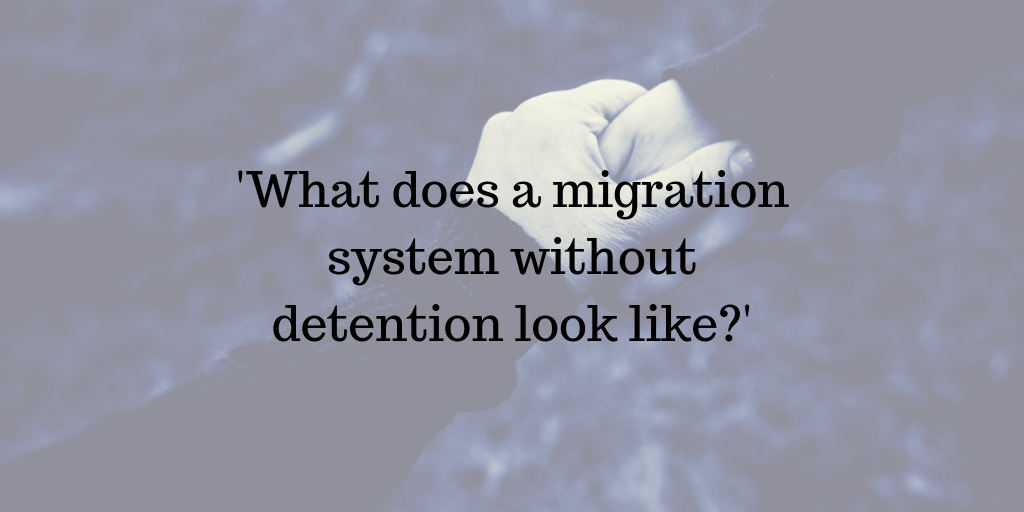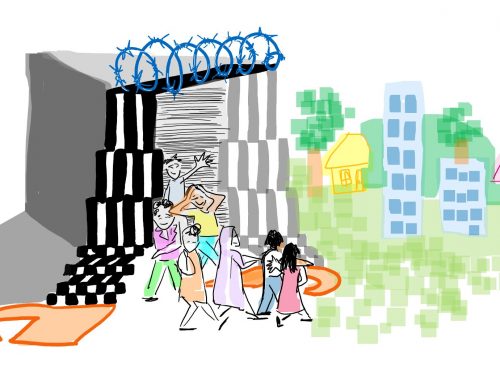‘What does a migration system without detention look like?’ – ATD blog 1
19 July 2019
In July 2018, the Home Secretary announced a new community-based alternative to detention pilot for vulnerable women detained in Yarl’s Wood or at risk of detention. We have been demanding that the Home Office work with civil society on alternatives, so we welcomed this breakthrough moment, but also recognised that this was only a first step.
In this blog series, we will piece together the story of the Detention Forum’s work on alternatives to detention, which began almost 10 years ago, and analyse this latest development in the work challenging immigration detention.
=====================================
In the early days of the Detention Forum meetings, many of us talked a great deal about the horrors of indefinite detention and the need for change. These conversations led to a firm collective resolve to take action. But they also posed the question of what we saw as an alternative vision for the future, that could be achieved in the near future.
What would a migration system without detention look like?
What needs to happen for the government to radically reduce and eventually end the detention of migrants?
How do we begin the process of transforming our migration system to become fair and humane, with migrants’ rights and dignity at its centre?
How do we move from outrage and critique to solutions and hope?
In addressing these questions, we spent years studying, investigating, discussing and exploring the idea of community-based alternatives to detention. We reached the conclusion that, with careful preparation and absolute determination, alternatives could be a powerful strategy to fundamentally challenge the use of detention and bring about a transformative change to the migration system. We did not see alternatives as a policy fix, we saw it as a process for system change.
You probably know about the Detention Forum’s flagship asks. We are demanding a 28 day time limit on detention, an end to the detention of vulnerable people and an introduction of 72 hour automatic judicial oversight of detention decision making. These asks were agreed in 2012 when our members spent one whole year developing our joint strategy.
At the same time, we also committed ourselves to explore alternatives. Once we felt more confident that this was a solid ask, we added it as the fourth ask to our list: a demand that the government develops and implements community-based alternatives to detention, in order to reduce the use of detention. In the long run, this could be even more radical than the other asks. By advocating for alternatives, we are saying that it is possible for deprivation of liberty to be taken out of the migration system and that the government can eventually do away with detention altogether. We incorporated this ask fully into our revised Theory of Change 2017 – 2020.
The concept of community-based alternatives to detention was, however, relatively unknown in the UK and there was generally little interest. Worse, it was and still is often greeted with hostility and suspicion by many NGOs. There are many reasons for this. It was partly because of the Home Office’s previous disastrous attempts at alternative to detention pilots which focused exclusively on returning asylum seeking families with children to their country of origin. Also there was much focus on bail, a process of being released from detention which, unlike best-practice community-based alternatives, is without independent, holistic case management support. Nevertheless, many feel that there is no need to have other processes or systems for migrants to live outside detention.
Alternatives to detention were also criticised on the grounds that they do not guarantee that everyone will receive a decision granting them leave to remain, even if they were to erase detention out of the picture.
The beginning of our alternatives journey was, therefore, slow and careful. It was certainly uncharted territory in the UK.
What we had in abundance was a clear sense of purpose and willingness to be open-minded. We knew that we had to be a few steps ahead of the government. We had to be more knowledgeable, more experienced and more ready, if and when they finally agreed to explore alternatives. We wanted to be in a position to be able to advise and guide that process, to make sure that alternatives do indeed lead to detention reduction and uphold migrants’ rights and dignity.
For years, while our public-facing work was very much about advocating and campaigning for a 28 day time limit, our behind-the-scenes work was all about alternatives. Our alternatives advocacy became an invaluable element of our core advocacy for ending indefinite detention and fair and humane treatment for vulnerable people.
So what are community-based alternatives to detention? Through independent and individually tailored case management, community-based alternatives to detention support people going through immigration procedures in the community without the use of detention. It is an approach that recognises the importance of engaging individuals, respecting their rights and dignity, helping them to be able to navigate the immigration procedure. It is an approach that is not run on the logic of enforcement, as exemplified by detention.
Outside the UK, some civil society organisations and governments have been running community-based ATD pilots or programmes, sometimes starting with small-scale pilots: why not the UK too? To achieve that, we needed to create momentum for community-based alternatives.
In the intervening years, we ran numerous workshops for interested Detention Forum members and experts-by-experience, to build our collective knowledge and confidence in alternatives and sharpen our arguments.
Through our ongoing discussions and advocacy training sessions over many years, we critically analysed alternatives’ potential and limitations and what NGOs’ roles could look like, so we would be clearer about the risks. These reflective exercises were crucial in strengthening our advocacy skills.
We wrote a report to clarify our own thinking and we developed and ran a pilot to test the hypothesis that alternatives can be effective addressing the drivers of detention in the UK – we felt we needed to know what we were talking about. We organised parliamentary sessions to prepare our parliamentary friends to seek political buy-in for the idea and submitted written evidence to many investigations and enquiries. Sensitising and educating key stakeholders and highlighting international good practice were important parts of normalising the idea: we did not want the next alternatives pilot to be another failure, putting an end to any future prospect of alternatives ever being taken up again. Our alternatives lobbying, piloting and evaluation also took us to Brussels, Strasbourg and beyond to strengthen regional-level language on community-based alternatives, so that it becomes more acceptable in the UK.
Then finally, a real turning point came in July 2018. In response to the follow-up Shaw Review, the UK government announced that it will initiate a new community-based alternative to detention pilot for vulnerable women who would otherwise be detained in Yarl’s Wood detention centre. The Home Secretary added that ‘there should be more alternatives to detention so that people can be held in the community, rather than in a detention centre, while their cases are being looked at’. Finally, the government was committing to reducing detention and developing alternatives. But would civil society and migrants be able to shape what happened next?
This was almost 12 months ago. In this blog series, we will outline what has been happening since, its context and future challenges.
Eiri Ohtani @EiriOhtani
===================================
Want to know more about alternatives to detention quickly? Our Frequently Asked Questions briefing paper, published just before the Home Secretary’s announcement on the ATD pilot, might be useful.





